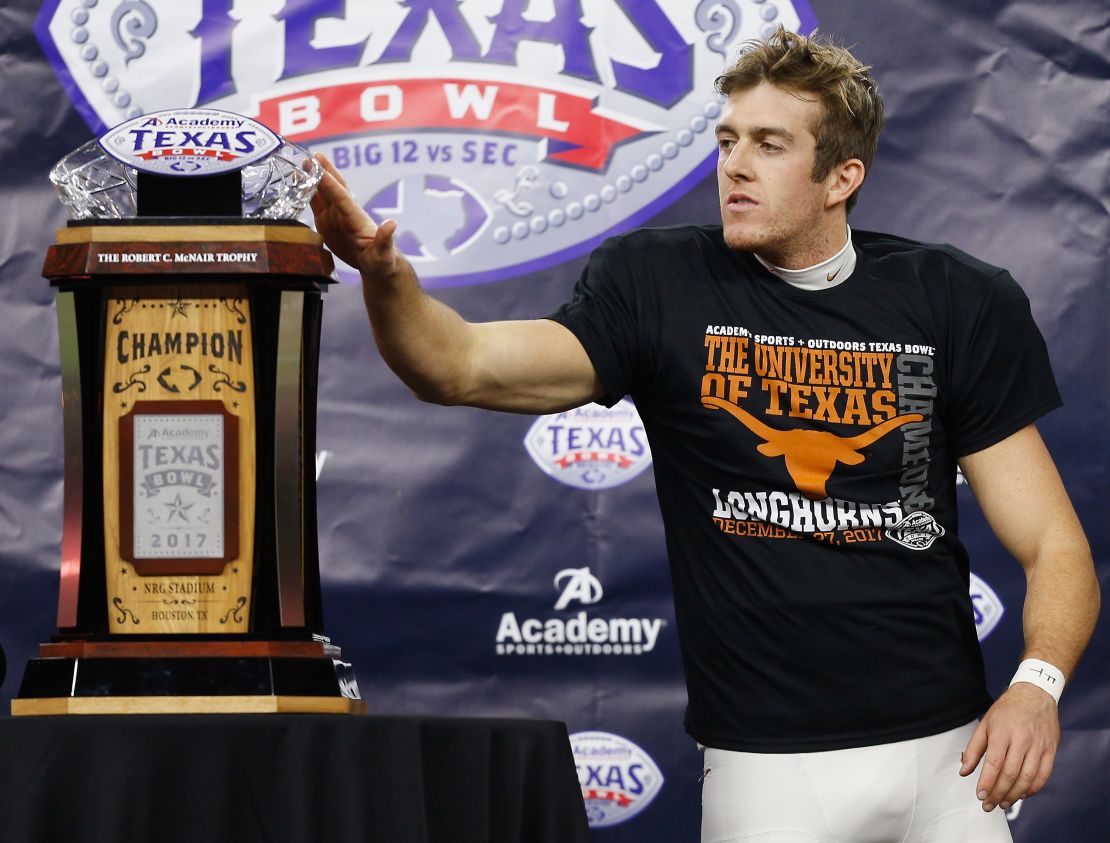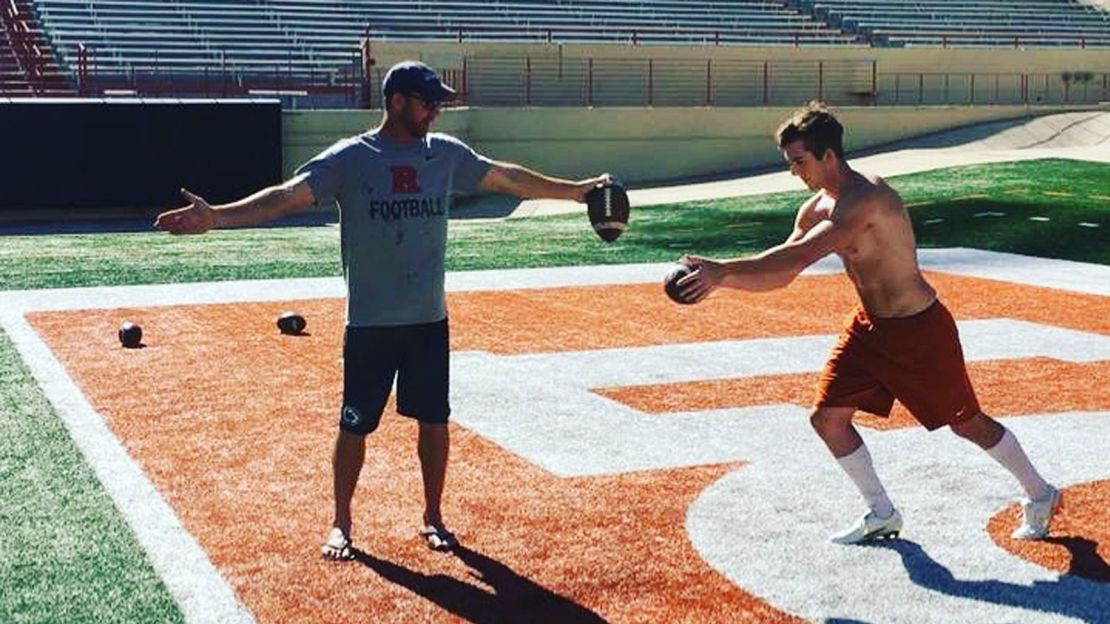Story highlights
65 Pro Kick punters are playing in NCAA Division I
Seattle Seahawks rookie is Pro Kick grad
When Australian punting coach Nathan Chapman looks back at his workout video for the Denver Broncos, he squirms.
“It makes me want to vomit,” he bluntly says of a moment that marked his short NFL preseason stint in 2004. “To think I was just kicking a ball without any technical knowledge at all.”
Things have come a long way since then.
Largely thanks to Chapman’s Pro Kick Australia school, founded on the lessons he learned as an NFL hopeful, the country is cranking out punters to major US college programs and infiltrating the pros.
No fewer than 65 Pro Kick graduates will suit up for Division I schools this year, according to Chapman, and three are likely to stick on NFL rosters.
They include Seattle Seahawks rookie Michael Dickson, who skipped his senior season at Texas after winning the Ray Guy Award, given to college football’s top punter.
Like most other Pro Kick students – and like Chapman himself – Dickson played Australian rules football and had little understanding of the sport the Aussies call “gridiron.”
No matter. After a brief tryout – which he attended on a whim with friend Oscar Bradburn, now with Virginia Tech – Dickson enrolled in Pro Kick in March 2015.
By September, he was booming punt after punt for the Texas Longhorns in front of more than 80,000 at Notre Dame.
“I never really watched a full game of American football until I played my first game against Notre Dame,” Dickson recently admitted to the Seattle Times. “It took me two years to really fully understand (the rules).”
Dickson’s talents shone in a win at the Texas Bowl in December, when he landed 10 punts inside Missouri’s 20-yard line and walked away as the game’s MVP.
Texas coach Tom Herman said he had never seen a punter affect a game that way.

“That’s what we try to do,” says Chapman. “We feel like our duty is to bring attention back to the punting game so that coaches realize, hey, if we’ve got a good one, we can attack more,”
Dickson will likely be joined in the NFL this season by fellow Pro Kick alumnus Jordan Berry of the Pittsburgh Steelers and Cameron Johnson of the Philadelphia Eagles.
Another Aussie rules convert Lachlan Edwards punts for the New York Jets, while compatriot Brad Wing is looking for a call up after three seasons with the New York Giants.
“Three to five Australians out of 32 (NFL teams) is not a bad ratio,” says Chapman.
Waiting in the wings are about a dozen Pro Kick punters in the Pac-12 Conference – where the speedy game suits Australian punters who are mobile, says Chapman – and others in the Southeastern Conference (SEC) and Big Ten Conference
As a result, American football is rapidly catching up with basketball as a sport where Australians are thriving in the US. Last year, 70 Aussies played Division I basketball, while another seven were on NBA rosters – including Rookie of the Year Ben Simmons.

‘We have a million punters’
In Australian rules football players score by kicking a oval ball between goalposts, often at long distances while on the run. The sport’s unique skill set makes it a breeding ground for Pro Kick.
“When it comes to punting, we have a million punters,” says Chapman, who earned his own shot with the Green Bay Packers after his eight-year career in Aussie rules ended.
Chapman was cut the week before the 2004 regular season, largely due to inexperience. “If I had known what the coaches actually wanted, I could have tied my kicking pursuit with (that) rather than just kicking blindly and wildly,” he says.
He also didn’t understand the business side of things.
The Packers used a third-round pick on Ohio State punter B. J. Sander, making it unlikely an unproven lad from Down Under would crack the roster, he says.
Greater awareness “would have allowed me to think I may have to look elsewhere,” he says. “I want people not to make those mistakes.”
His experience spawned Pro Kick.
He remembers thinking, “With a little bit of guidance to do this right, there are many guys in Australia who can kick a football and succeed at this.” He also thought, “If you go about it the wrong way 20 more will fail.”

‘It’s like ordering pizza’
Chapman opened his school in Melbourne in 2007, but soon realized his pupils would be better served approaching US colleges rather than gunning straight for the NFL.
The fees are not cheap, starting at nearly $11,000 for a one-year course, which encompasses three days a week of punting practice and two days in the weight room, along with academic preparation to meet NCAA eligibility rules.
But Chapman stresses that Pro Kick is open only by invitation to those who he thinks have the ability to make it as punters. The fees, he says, are more an investment in their future, virtually guaranteeing a full ride at a US university.
“Ninety-five percent of the people in our program have walked away with $180,000,” Chapman says, estimating the value of a four-year scholarship.
What helps Pro Kick’s success rate is Chapman’s close relationship with a number of US college coaches, who he declined to name because of the sensitivity of their arrangement.
Many, he says, will take a player on his word – often without even seeing them kick in person.

“It’s like ordering a pizza,” Chapman says. “You tell us what you want and we will go get it.
“You want this type of leg, this type of strength, this type of kick? We’ve got the player you want … let’s go and train him for the next six to eight months, and then we’ll deliver him on your doorstep.
“That’s pretty much how it works.”
Pro Kick’s strength lies in punting, but teaches other positions, namely placekicking, to about 10% of students, and punt returning.
Former Hawaii standout Scott Harding, who could punt with distance from both legs, also learned to catch at Pro Kick.
Remarkably, he was Hawaii’s starting punter, punt returner, and second leading receiver in 2013.
The highest-paid NFL players in 2018
Coming to America
Aside from teaching the rules of the game, the most important lessons learned at Pro Kick are the cultural nuances that young Australians will face in America.
“Most have never been to the US when they get there,” Chapman explains. “We teach them what it’s like at college.
“What the other schools are, what the rules are, having girlfriends there, the police systems, the cultural things in the North and the South, saying ‘Yes ma’am’ …
“So that all they want to do when they get there is just kick the damn ball.”





















